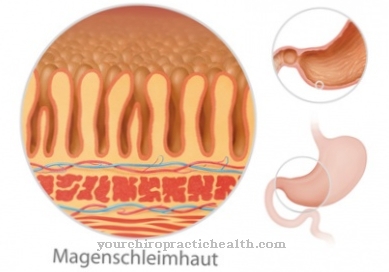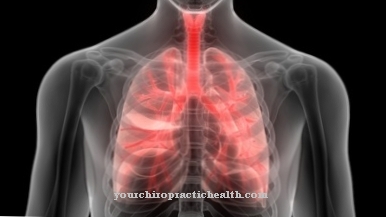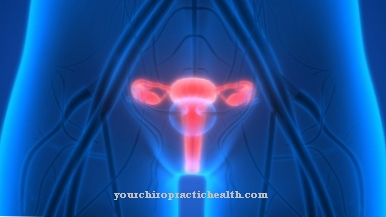The Ventilation perfusion ratio describes the quotient of pulmonary ventilation and pulmonary perfusion. The normal values of the parameter are between 0.8 and one for a healthy person. Deviations are based on the principle of an intrapulmonary right-left shunt or increased alveolar dead space ventilation.
What is the ventilation to perfusion ratio?

Lung ventilation is also known as ventilation. Medicine includes the ventilation of the entire respiratory tract during breathing. The gas exchange takes place via the alveolar ventilation. The structures less involved in gas exchange are also ventilated. The doctor also speaks of dead space ventilation.
The ventilation perfusion quotient refers to the ratio between the total ventilation of the lungs and their perfusion. The flow of blood is called perfusion. With the ventilation perfusion quotient, the perfusion corresponds to the cardiac output, which is calculated from the stroke volume times the heart rate. The norm for cardiac output is around five liters. The perfusion of the lungs is between five and eight liters. The ventilation in a healthy adult is around five to seven liters. At rest, the ventilation-perfusion ratio averages between 0.8 and one.
The quotient of the two volumes is a parameter of the respiratory gas analysis that is used in pneumology for diagnostics.
Function & task
Lung breathing is vital for humans. Gas exchange takes place in the alveoli of the paired organ. Oxygen is absorbed with the air we breathe. Carbon dioxide is released into the environment at the same time. If too much CO remained in the body, it would cause symptoms of poisoning or even death. Similarly, an insufficient supply of oxygen can lead to death.
Every tissue in the body is permanently dependent on a supply of O2 for maintenance. If the oxygen supply fails for a certain period of time, the tissue dies. In organs, organ failure is the result of this process.
In the alveoli, oxygen is passed from the air you breathe into the bloodstream. The blood is used as a transport medium in lung breathing. In this way, the oxygen reaches even the tightest tissues via the bloodstream. Oxygen is transported in the blood in both dissolved and bound form. The molecules of oxygen bind to the hemoglobin in human blood. Its binding affinity decreases in the increasingly acidic environment of the rest of the body. In this way, the oxygen separates from the hemoglobin on its journey through the bloodstream and can be absorbed into the tissues.
The norm of the ventilation-perfusion quotient describes the ideal of the ratio of blood flow and ventilation that the lungs need to supply the body with oxygen. The alveolar ventilation and perfusion differ from one another because of the force of gravity in the individual lung sections. With an upright thorax (chest), perfusion and ventilation gradually increase from the tip of the lung to the base of the lung. The vertical ventilation gradient is less pronounced than the perfusion gradient.
The variable bronchial and vascular supply in the lung regions makes the ventilation-perfusion inhomogeneity even more extreme. For example, the regional ratio in the basal sections is only 0.5. At the top of the lungs, on the other hand, it is up to three. The mean of these numbers gives a ventilation-perfusion quotient of about one.
The areas above the mean value are called hyperventilated and the areas below the mean value are called hypoventilated areas. Hyperventilated areas are, for example, the alveoli. They contribute more to gas exchange than the hypoventilated districts. The inhomogeneity of perfusion and ventilation is increased when the lung function is impaired and the gas exchange capacity of the lungs worsens.
You can find your medication here
➔ Medication for shortness of breath and lung problemsIllnesses & ailments
A deviating ventilation / perfusion ratio can be based on two different principles. The first principle corresponds to a deviation due to an intrapulmonary right-left shunt. The alveoli are not ventilated, but perfused and mix mixed venous blood into the body's circulation. The right-left shunt is a disturbance in the blood circulation that pumps oxygen-poor blood from the venous limbs into the arterial limb without going through the pulmonary circulation.
The cause of such a phenomenon can be an atrial or ventricular septal defect, which creates a direct connection between the large vessels of the body. The right ventricular pressure thus exceeds the left ventricular pressure. A surfactant deficiency can also trigger the phenomenon by causing insufficient ventilation in the basal areas of the lungs.
The second principle for an abnormal ventilation-perfusion ratio corresponds to increased alveolar dead space ventilation. The alveoli are not perfused, but ventilated and thus reduce the effective ventilation, as the respiratory minute volume increases in a compensatory manner. The partial pressure of the carbon dioxide remains unchanged despite breathing.
Disturbances in pulmonary gas exchange with changed blood gas values are also referred to as respiratory insufficiency. This can occur in the event of imbalances in the ventilation-perfusion ratio. The partial respiratory failure corresponds to arterial hypoxemia with an oxygen partial pressure below 65 mmHg.
In global respiratory insufficiency, there is hypoxemia and hypercapnia. The carbon dioxide partial pressure is therefore above 45 mmHg. The main symptoms of insufficiency include shortness of breath, restlessness and a racing heart. If the course is severe, impaired consciousness and bradycardia may also occur. Pathological breathing noises or rattling noises also occur.



























